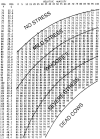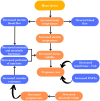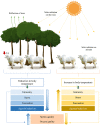Animal welfare and effects of per-female stress on male and cattle reproduction-A review
- PMID: 37065229
- PMCID: PMC10102491
- DOI: 10.3389/fvets.2023.1083469
Animal welfare and effects of per-female stress on male and cattle reproduction-A review
Abstract
Thermal stress causes severe effects on the wellbeing and reproduction of cattle, including changes in oogenesis and spermatogenesis, generating great concerns, which last for decades. In cattle, the occurrence of thermal stress is associated with a reduction in the production of spermatozoids and ovarian follicles, in addition to the increase of major and minor defects in gametes or in their intermediate stages. In bovine females able to reproduce, a reduction in the rate of estrus manifestation and an increase in embryonic mortality has been observed. Therefore, keeping animals on good welfare conditions, with water supply and in shaded areas can favor the improvement of different reproductive parameters. For all this, the present study aimed to gather, synthesize and argue recent studies related to animal welfare, focusing on the effects of thermal stress on the reproduction of cattle, aiming to support possible strategies to mitigate the harmful effects of thermal stress in this species.
Keywords: heat load; reproduction; spermatogenesis; thermal stress; thermotolerance.
Copyright © 2023 Silva, Silva, Camargo-Júnior, Silva, Santos, Viana, Silva, Silva and Lourenço-Júnior.
Conflict of interest statement
The authors declare that the research was conducted in the absence of any commercial or financial relationships that could be construed as a potential conflict of interest.
Figures












Similar articles
-
Reproductive physiology and endocrinology responses of cows exposed to environmental heat stress - Experiences from the past and lessons for the present.Theriogenology. 2020 Oct 1;155:150-156. doi: 10.1016/j.theriogenology.2020.05.040. Epub 2020 Jun 6. Theriogenology. 2020. PMID: 32679440 Review.
-
The Impact of Heat Load on Cattle.Animals (Basel). 2019 Jun 6;9(6):322. doi: 10.3390/ani9060322. Animals (Basel). 2019. PMID: 31174286 Free PMC article. Review.
-
Major advances associated with environmental effects on dairy cattle.J Dairy Sci. 2006 Apr;89(4):1244-53. doi: 10.3168/jds.S0022-0302(06)72193-2. J Dairy Sci. 2006. PMID: 16537957 Review.
-
Strategies for managing reproduction in the heat-stressed dairy cow.J Anim Sci. 1999;77 Suppl 2:36-50. doi: 10.2527/1997.77suppl_236x. J Anim Sci. 1999. PMID: 15526779 Review.
-
The Effect of Stress on Reproduction and Reproductive Technologies in Beef Cattle-A Review.Animals (Basel). 2020 Nov 11;10(11):2096. doi: 10.3390/ani10112096. Animals (Basel). 2020. PMID: 33187308 Free PMC article. Review.
Cited by
-
Evaluation of the Composition of the Cholesterol, Tocopherols, β-Carotene and Fatty Acids Profile of the Liver Tissue of Male Water Buffaloes (Bubalus bubalis) Managed in Different Ecosystems of the Eastern Amazon.Animals (Basel). 2023 Dec 8;13(24):3785. doi: 10.3390/ani13243785. Animals (Basel). 2023. PMID: 38136822 Free PMC article.
-
Reproductive Efficiency of Nelore Cows in Fixed-Time Artificial Insemination Programs with Early Resynchronization.Vet Sci. 2025 Jan 8;12(1):27. doi: 10.3390/vetsci12010027. Vet Sci. 2025. PMID: 39852903 Free PMC article.
-
The Characterization of Pastures by Grazing Cycle and Evaluation of Supplementation with Agro-Industry Co-Products on the Performance of Buffaloes in the Humid Tropics.Animals (Basel). 2024 Mar 13;14(6):879. doi: 10.3390/ani14060879. Animals (Basel). 2024. PMID: 38539977 Free PMC article.
-
Heterogeneity of variance and genetic parameters for milk production in cattle, using Bayesian inference.PLoS One. 2023 Jul 12;18(7):e0288257. doi: 10.1371/journal.pone.0288257. eCollection 2023. PLoS One. 2023. PMID: 37437036 Free PMC article.
-
A Review of the Rumen Microbiota and the Different Molecular Techniques Used to Identify Microorganisms Found in the Rumen Fluid of Ruminants.Animals (Basel). 2024 May 13;14(10):1448. doi: 10.3390/ani14101448. Animals (Basel). 2024. PMID: 38791665 Free PMC article. Review.
References
-
- OIE (World Organization for Animal Health). Definição de bem-estar animal. (2019). Available online at: https://www.oie.int/en/what-we-do/standards/codes-and-manuals/terrestria... (accessed August 15, 2022).
-
- Costa PT, Silveira IDB, Silveira RF, Vaz RZ, Fernandes TA, Moreira SM, et al. . Características comportamentais dos bovinos: Aspectos básicos, processo de aprendizagem e fatores que as afetam. REDVET Revista Electrónica de Veterinaria. (2017) 18:1–16.
-
- Marques JA, Maggioni D, Abrahão JJS, Guilherme E, Arruda Bezerra G, Lugão SM. Comportamento de touros jovens em confinamento alojados isoladamente ou em grupo. Archivos Latino americanos de Produccinon. Animal. (2005) 13:97–102.
Publication types
LinkOut - more resources
Full Text Sources

